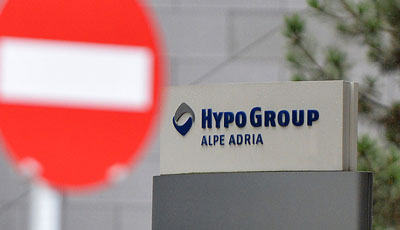Debunking $1.4 Trillion Europe Debt Myth in Post-Heta Age

Austria’s decision to burn bondholders of a failed state bank may mean almost 1.3 trillion euros ($1.4 trillion) of European debt once deemed risk-free now comes with a hazard warning.
Austria is the first country to wind down a bank, Heta Asset Resolution AG, under the European Union’s new Bank Recovery and Resolution Directive after changing laws last year to allow it to write down subordinated debt of its failed predecessor, Hypo Alpe-Adria-Bank International AG. The government is also refusing to stand behind guarantees by the province of Carinthia on Heta’s senior debt. The moves are putting bondholders at risk of losses.
As age-old banking mores clash with modern banking rules, investors are being forced to take a second look at how governments have used explicit or implicit promises in the past to issue debt that doesn’t show up in official ledgers.
“People had too much trust in public authorities,” said Otto Dichtl, a credit analyst for financial companies at Stifel Nicolaus Europe Ltd. “Austria dropping Carinthia like this is an extraordinary step. We have to see just how this is carried out. From a legal perspective, this is uncharted territory.”
Based on current bond prices, Heta’s senior creditors, who bought securities covered by a guarantee from Carinthia province, face losses of more than 40 percent on their 10.2 billion euros of debt. Carinthia, a southern Austrian region of 556,000 people with annual revenue of less than 2.4 billion euros, may face insolvency if the guarantees are triggered.
Debt Guarantees
Until this year, figures for debt guarantees weren’t disclosed in most European countries, a fact that helped Greece conceal its true debt levels to gain entry to the euro in 2001. Greece undertook the biggest debt restructuring on record in 2012.
New rules by the European Council, known as the “six pack” directive, led to data as of 2013 being published for the first time last month, revealing 1.28 trillion euros of government guarantees.
The EU introduced the six laws in 2011 to make sure its member states observed the bloc’s budget rules and provided more comparable and transparent budget data.
As the EU’s biggest user of guarantees, Austria has contingent liabilities corresponding to 35 percent of national output, or 113 billion euros, the data show.
It isn’t just Austria that has liberally applied state guarantees. Ireland has contingent liabilities equivalent to 32 percent of its economy, reflecting the collapse of its banking system, while Germany’s tally stands at more than 18 percent of output.
German Guarantees
German guarantees, encompassing 512 billion euros, are the biggest in absolute terms, followed by Spain with 193 billion euros and France with 117 billion euros.
To be sure, state-guaranteed debt and the covered bonds banks sell using such notes are still generally safe investments, said Dichtl at Stifel Nicolaus. “That’s the assumption as long as reality doesn’t prove otherwise and the situation in Austria shows that can happen,” he said.
Pledges by Austria’s federal, provincial and local governments include Carinthia’s Heta guarantees and those of the country’s other provinces for their regional banks — even after several of these have been sold to private investors.
Motorway operator Asfinag, export financier Oesterreichische Kontrollbank AG, and hospital operators such as Carinthia’s Kabeg are among the public debtors affected.
Greeks Next?
A glance at Heta’s 1.25 billion euros of 4.25 percent notes due October 2016 shows the extent of the loss investors anticipate. The bonds are quoted at 59 cents on the euro, while the company’s 2 billion euros of 4.375 percent bonds maturing January 2017 are quoted at about 60 cents on the euro, according to data compiled by Bloomberg.
“The Austrians don’t look like they’re going to back down on this and who could be next — the Greeks?” said Roger Kiem, a partner at law firm White & Case in Frankfurt. “Even the Spanish might come into question when you look at the liabilities of their vehicles for winding down legacy bank assets.”
Heta’s predecessor, Hypo Alpe, was the biggest beneficiary of Carinthia’s open-handedness with guarantees. Fueled by the cheap funding offered by state backing and cheered on by the late Joerg Haider, the right-wing populist who was the region’s governor until his death in 2008, the lender expanded at a rapid pace in the 2000s, focusing on the Balkans.
That strategy lured Munich-based Bayerische Landesbank, Germany’s second-largest state-owned lender, which wanted to enter Hypo Alpe’s markets in Croatia, Serbia and Slovenia, and in 2007 agreed to buy a majority stake for 1.63 billion euros.
BRRD Directive
The bust came in 2009, when Austria had to rescue Hypo Alpe. The Austrian government and BayernLB are now suing each other, two of at least eight lawsuits involving Heta.
The BRRD directive, which all EU countries have to adopt in full by the start of 2016, insists on creditors taking losses before taxpayers step in.
Payments on Heta’s debt have been halted while the Austrian regulator decides on a level of losses. While Carinthia’s guarantee on Heta’s senior debt still stands, Austria has made it clear that the pledge is the province’s problem.
Carinthia has said it won’t be able to pay up without federal help and last week requested loans from the Austrian Treasury saying it is losing access to capital markets. The government instead has vowed to stand behind its own guarantee on 1 billion euros of Heta’s subordinated debt.
Change Rules
Austria’s actions are yet another example that government debt is not risk free because “governments can change the rules,” Commerzbank AG Chief Executive Officer Martin Blessing said at a March 12 event at London School of Economics.
“The Austrian situation could guide investors’ decisions involving state guarantees in other countries too,” said Carola Schuler, an analyst at Moody’s Investors Service in Frankfurt. “What the Heta/Carinthia case shows is that the value of the guarantees depends on the legal structure as well as the economic sustainability.”
FMS Wertmanagement AoeR, the bad bank of failed German Hypo Real Estate Holding AG, became the first creditor to sue Heta after it didn’t repay a 450 million-euro bond March 6, of which FMS owned 200 million euros. A bondholder committee is forming and has picked London-based Kirkland & Ellis as legal counsel, two people with knowledge of the matter said last week.
Legal Uncertainties
“You have very old laws like the state bank guarantees entangled with very new ones like the BRRD, which are conceptually completely different,” Moody’s Schuler said. “That creates legal uncertainties about the status of the various creditors, and this will probably remain unresolved for a while.”
The tangle of legal questions facing Heta, Carinthia, creditors, auditors, owners and regulators include when and to what extent guarantees are or will be triggered, who has jurisdiction and where, who’s liable, possibly even financially, because of lack of oversight, and whether criminal acts have been committed.
“The irony is that an instrument that was designed to promote stability on financial markets is now causing uncertainty,” said Kiem at White & Case. “It’s only a question of time until investors start to question whether the other state guarantees against risk really stand.”
Source: Bloomberg – Debunking $1.4 Trillion Europe Debt Myth in Post-Heta Age




























